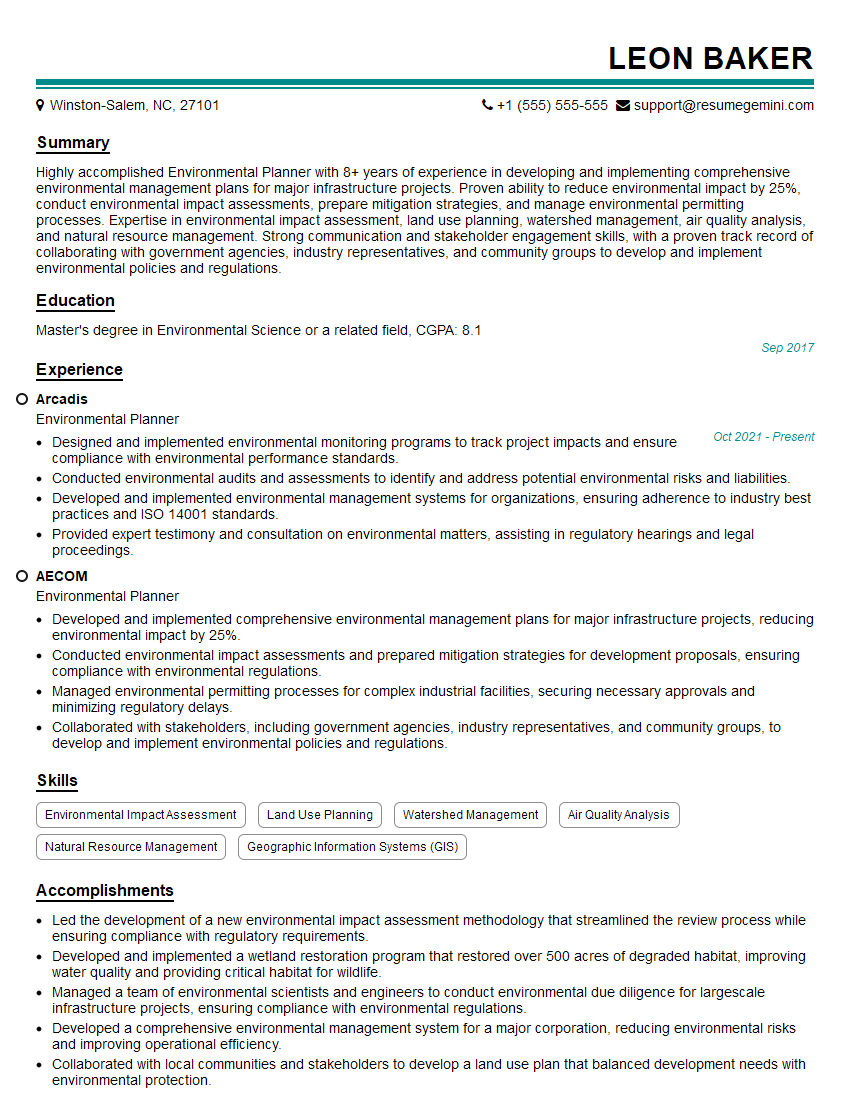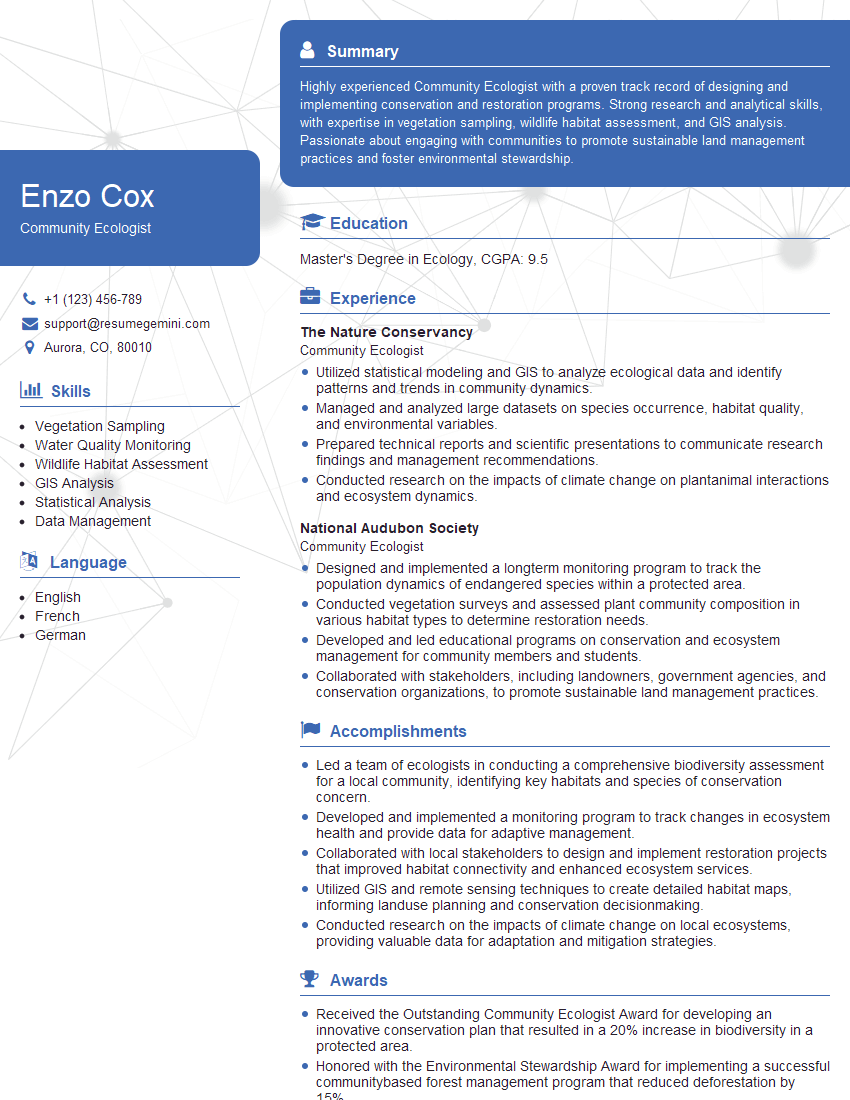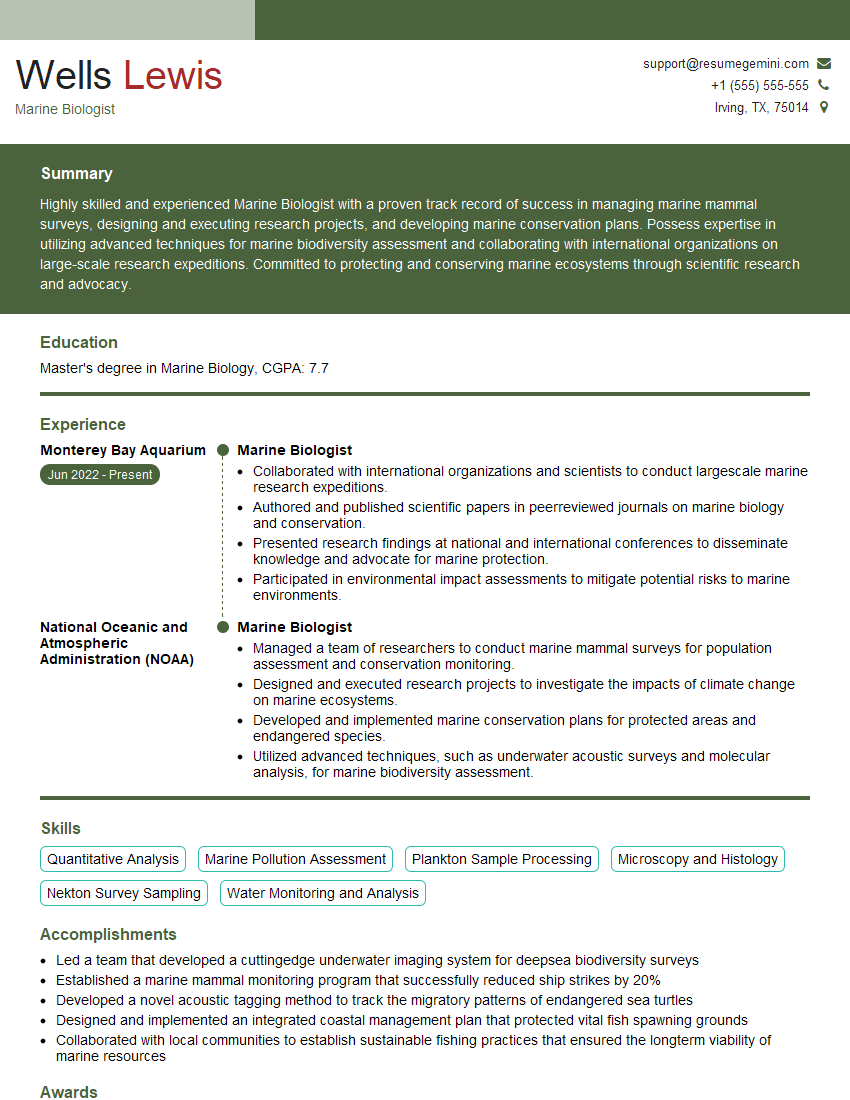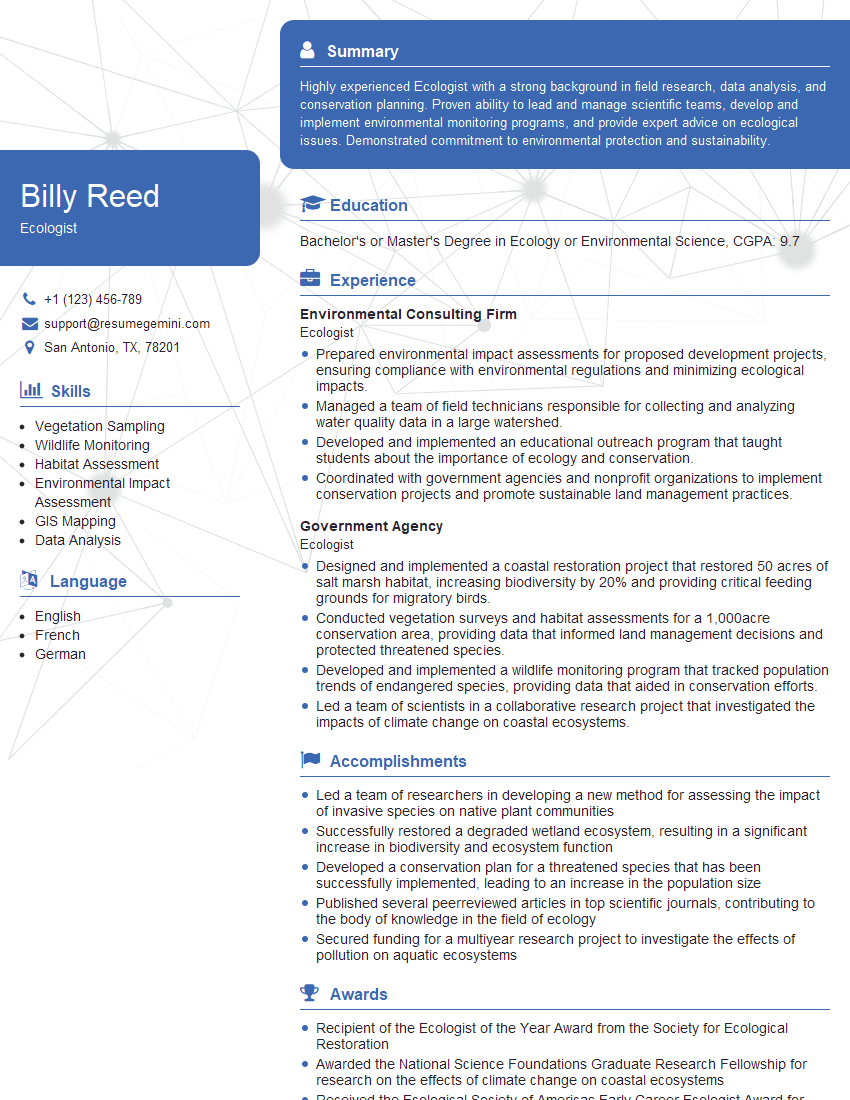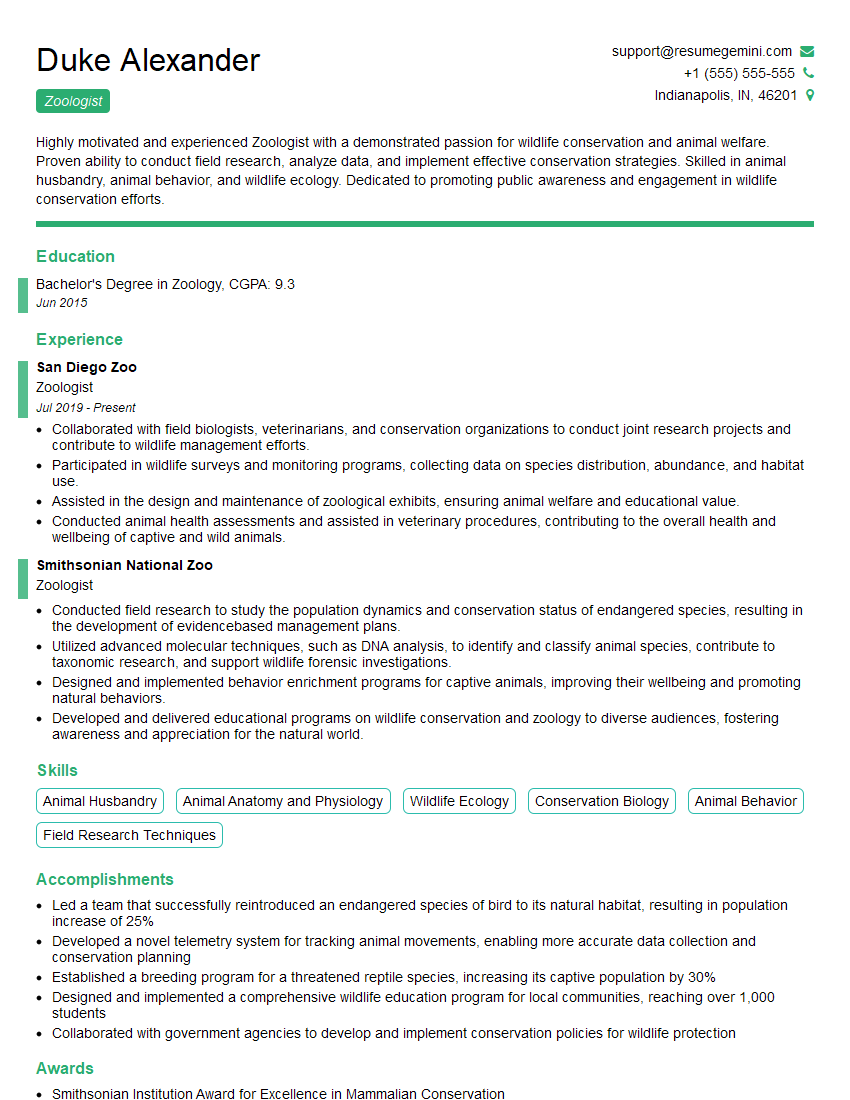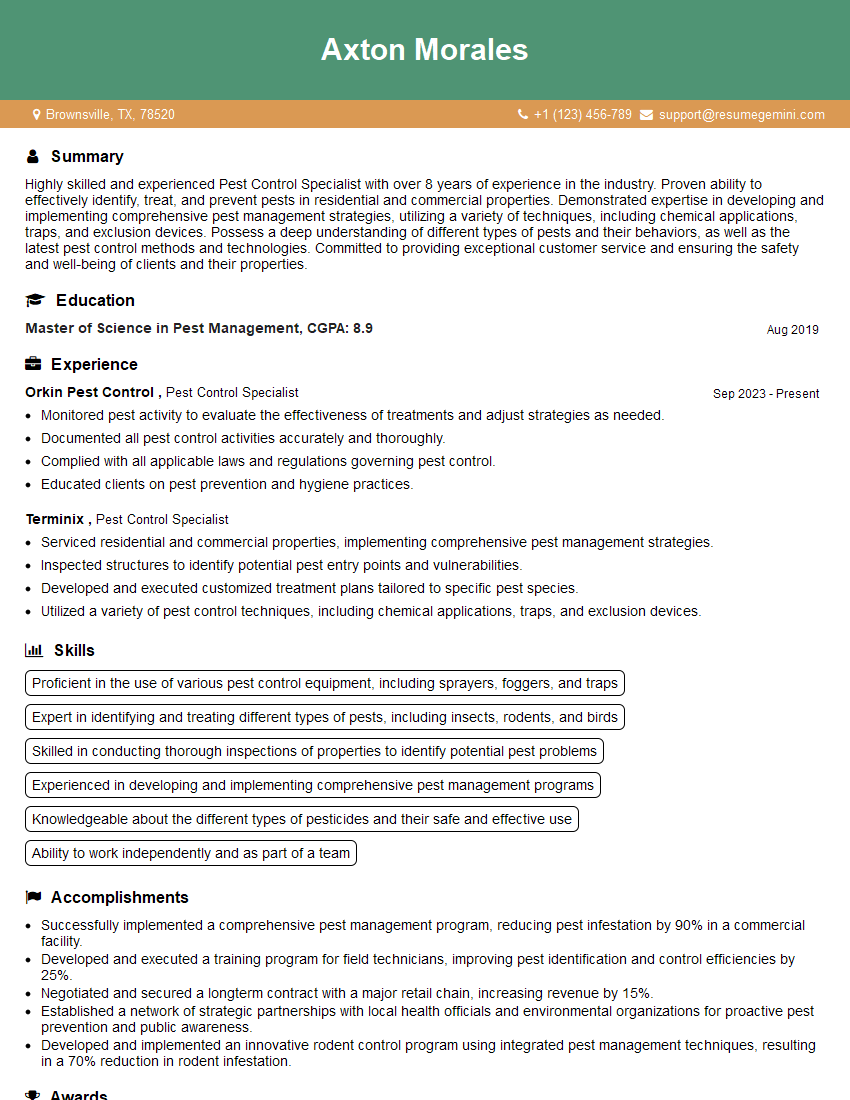Every successful interview starts with knowing what to expect. In this blog, we’ll take you through the top Predator-Prey Relationships interview questions, breaking them down with expert tips to help you deliver impactful answers. Step into your next interview fully prepared and ready to succeed.
Questions Asked in Predator-Prey Relationships Interview
Q 1. Explain the Lotka-Volterra model and its limitations.
The Lotka-Volterra model is a pair of differential equations that describe the dynamics of predator and prey populations. It’s a foundational model in ecology, illustrating how the populations of predators and prey can fluctuate over time in a cyclical pattern. Imagine a simple system with rabbits (prey) and foxes (predators). The model suggests that as the rabbit population grows, there’s more food for the foxes, leading to an increase in the fox population. However, this increased predation then reduces the rabbit population, eventually causing a decline in the fox population due to lack of food. This cycle continues, creating oscillations in both populations.
However, the Lotka-Volterra model has several limitations. It assumes:
- Constant growth rates: The prey population grows exponentially in the absence of predators, which is unrealistic in most natural systems.
- Unlimited resources for prey: The model doesn’t account for factors like resource scarcity that could limit prey growth.
- Instantaneous predator response: Predators are assumed to respond immediately to changes in prey density, which is often not the case.
- No density dependence: The model ignores density-dependent effects like competition within predator or prey populations.
- No refuge for prey: It doesn’t consider the possibility of prey finding refuge from predators.
These limitations mean that the Lotka-Volterra model is a simplification of reality, useful for illustrating basic predator-prey dynamics but insufficient to fully capture the complexities of natural systems. More realistic models incorporate density dependence, functional responses (discussed below), and other ecological factors.
Q 2. Describe the concept of functional response in predator-prey interactions.
The functional response describes the relationship between the rate at which a predator consumes prey and the density of the prey population. It essentially answers the question: how does the number of prey a predator eats change as the number of prey available increases? There are three main types:
- Type I: A linear relationship. The number of prey consumed increases proportionally with prey density up to a maximum consumption rate. This is often unrealistic as predators will eventually have to spend time handling prey and will not be able to consume indefinitely.
- Type II: A decelerating curve. Initially, the consumption rate increases with prey density, but then levels off as the predator reaches its maximum consumption rate (due to handling time limitations). This is a common pattern in nature.
- Type III: An S-shaped curve. At low prey densities, consumption is low due to search time limitations (e.g., prey is too scattered to find easily). As prey density increases, consumption increases rapidly until it levels off, similar to Type II.
Understanding functional responses is crucial for predicting predator-prey dynamics. A Type II functional response, for example, implies that even with high prey densities, predation rates will be limited by the predator’s ability to handle and consume prey.
Q 3. What are the different types of predator-prey relationships?
Predator-prey relationships come in various forms, varying in the level of specialization and the nature of the interaction. Here are a few examples:
- Ambush predation: Predators lie in wait and attack unsuspecting prey (e.g., a praying mantis catching a fly).
- Stalking predation: Predators actively search for and pursue their prey (e.g., a lion hunting a zebra).
- Herbivory: Predation where the predator (herbivore) consumes plants (e.g., a rabbit eating grass). Although generally less lethal than carnivory, it can have significant impact on plant populations and ecosystems.
- Parasitism: A type of predation where the predator (parasite) lives on or in its host (prey) for a prolonged period, usually without immediately killing it (e.g., a tick on a deer).
- Parasitoidism: Similar to parasitism, but the parasite eventually kills its host (e.g., a wasp laying eggs inside a caterpillar).
The distinctions between these types are not always clear-cut. Many predators employ a combination of strategies, and the lines between parasitism and predation can be blurry.
Q 4. How do prey species evolve defenses against predators?
Prey species have evolved a remarkable array of defenses against predators through natural selection. These defenses can be broadly categorized into:
- Physical defenses: These include features like shells (tortoises), spines (porcupines), tough skin (rhinos), or camouflage (chameleons) that make the prey less vulnerable to attack.
- Chemical defenses: Many prey produce toxins or unpleasant-tasting compounds to deter predators (e.g., poison dart frogs, monarch butterflies).
- Behavioral defenses: These include behaviors such as fleeing, hiding, freezing, or alarm calls to warn others of danger. Some prey even exhibit mimicry, mimicking dangerous species to avoid predation (e.g., viceroy butterfly mimicking the monarch).
- Group defenses: Living in groups can provide safety in numbers, increasing vigilance and allowing for collective defense (e.g., herds of wildebeest, flocks of birds).
The evolution of these defenses is a constant arms race, driven by the selective pressure exerted by predators. The more effective the defense, the greater the survival and reproductive success of the prey carrying that defense.
Q 5. How do predators adapt to overcome prey defenses?
Predators, too, are involved in an evolutionary arms race, constantly adapting to overcome the defenses their prey have evolved. These adaptations often mirror the types of prey defenses:
- Overcoming physical defenses: Predators may develop stronger jaws, specialized teeth, or claws to penetrate shells or tough skin (e.g., the powerful jaws of wolves or the crushing beak of an eagle).
- Tolerance to chemical defenses: Some predators evolve resistance to toxins produced by their prey (e.g., some snakes are resistant to the venom of their prey).
- Sophisticated hunting strategies: Predators may develop more effective hunting techniques to overcome behavioral defenses. For example, they might learn to hunt in packs or develop superior ambush strategies (e.g., cooperative hunting in lions).
- Sensory adaptations: Predators might improve their senses to detect camouflaged prey or develop heightened sensitivity to prey alarm calls (e.g., the excellent hearing and smell of wolves).
This ongoing co-evolutionary process shapes the diversity and complexity of both predator and prey populations.
Q 6. Explain the concept of co-evolution in predator-prey systems.
Co-evolution in predator-prey systems refers to the reciprocal evolutionary changes that occur in interacting species. As prey evolve defenses, predators evolve counter-adaptations, and vice versa. This constant interplay drives the evolution of both groups. It’s a continuous cycle of adaptation and counter-adaptation. Imagine it like a game of chess: every move by one player (prey developing a defense) forces the other player (predator developing a counter strategy) to respond, resulting in a dynamic, constantly evolving system.
A classic example is the evolutionary arms race between the rough-skinned newt (which produces a potent toxin) and its garter snake predator (which has evolved resistance to the toxin). The newt continually increases its toxin production, while the snake simultaneously increases its resistance, resulting in a co-evolutionary escalation.
Q 7. Describe the impact of habitat fragmentation on predator-prey interactions.
Habitat fragmentation, the breaking up of large, continuous habitats into smaller, isolated patches, can have significant impacts on predator-prey interactions. These effects are often negative for both predator and prey populations:
- Reduced prey availability: Smaller habitat patches support smaller prey populations, potentially leading to food shortages for predators.
- Increased risk of local extinction: Small populations are more vulnerable to extinction due to random events or fluctuations in prey availability.
- Altered predator-prey ratios: Fragmentation can disproportionately affect predators or prey, leading to imbalances in the predator-prey ratio.
- Edge effects: The edges of fragmented habitats can be more exposed to human disturbance and predation, increasing the vulnerability of both predators and prey.
- Increased human-wildlife conflict: Fragmentation can force predators into closer contact with human settlements, increasing the risk of human-wildlife conflict.
Understanding the effects of habitat fragmentation on predator-prey interactions is critical for conservation efforts. Strategies such as habitat restoration and creating wildlife corridors can help mitigate the negative consequences of fragmentation.
Q 8. How does climate change affect predator-prey relationships?
Climate change significantly impacts predator-prey relationships by altering habitat suitability, resource availability, and the timing of biological events. Think of it like this: if a predator relies on specific prey found in a shrinking ice cap, climate change melting that ice will directly threaten both species.
Specific impacts include:
- Range Shifts: As climates change, species may shift their geographic ranges. If the predator’s range shifts faster or slower than its prey’s, the balance can be disrupted, potentially leading to population decline or even extinction for one or both.
- Phenological Mismatches: Changes in temperature and precipitation can alter the timing of seasonal events like breeding and migration. If a predator’s migration doesn’t align with its prey’s peak abundance, it faces starvation.
- Increased Competition: Climate change can exacerbate competition between species for resources. A warmer climate might allow a new competitor to thrive, impacting both predator and prey populations.
- Changes in Prey Abundance: Altered environmental conditions can directly impact prey populations, decreasing their overall abundance and putting pressure on predators.
For example, changes in sea ice extent directly affect polar bears (predator) and their seal prey, leading to reduced hunting success for the bears.
Q 9. What are the key factors influencing predator-prey population cycles?
Predator-prey population cycles are complex, driven by a fascinating interplay of factors. These cycles often exhibit oscillations, meaning the populations rise and fall in a somewhat predictable manner.
- Food Availability: The most obvious factor is the amount of prey available. If prey is abundant, the predator population grows. However, as the predator population increases, it consumes more prey, leading to a decline in prey numbers. This decline, in turn, impacts the predator population.
- Predator-Prey Efficiency: How effectively predators hunt and capture their prey, and the prey’s ability to evade capture, significantly influence population dynamics. Improved hunting techniques or increased prey vulnerability can drastically alter population cycles.
- Disease and Parasitism: Outbreaks of disease in either the predator or prey population can drastically alter their numbers, disrupting the normal cycle.
- Competition: Competition among predators for the same prey, or competition among prey for resources, can alter the cycling pattern.
- Environmental Factors: Factors like climate, habitat availability, and catastrophic events (fires, floods) can impact both predator and prey populations and their interactions.
The classic example is the lynx and snowshoe hare cycle, where their populations fluctuate in a remarkably regular pattern over time. However, these cycles are rarely perfectly predictable and often influenced by stochastic (random) events.
Q 10. Explain the role of keystone species in predator-prey dynamics.
Keystone species are those whose impact on their ecosystem is disproportionately large relative to their abundance. In predator-prey dynamics, these species often play crucial roles in maintaining biodiversity and community structure. Removing a keystone predator can lead to trophic cascades, causing dramatic changes throughout the entire ecosystem.
How Keystone Predators Influence Predator-Prey Dynamics:
- Regulating Prey Populations: Keystone predators prevent any single prey species from dominating, thus maintaining diversity among prey populations. Imagine a keystone predator controlling a population of herbivores; without it, the herbivores could overgraze, leading to habitat destruction.
- Maintaining Ecosystem Stability: By keeping prey populations in check, keystone predators prevent dramatic shifts in the ecosystem. This stability supports a wider array of species.
- Indirect Effects: Keystone predators can indirectly affect other species through their interactions with intermediate species. For example, a predator might control a species that competes with another, influencing the abundance of the latter.
Sea otters are a classic example of a keystone predator. Their predation on sea urchins prevents the urchins from overgrazing kelp forests, supporting a rich and diverse ecosystem.
Q 11. Describe different methods for estimating predator-prey populations.
Estimating predator-prey populations requires a combination of methods, as no single technique is perfect. The choice of method depends on the species, the environment, and the resources available.
- Mark-Recapture: Animals are captured, marked, released, and then recaptured later. The proportion of marked individuals in the recapture sample helps estimate the total population size.
- Transect Surveys: Observers walk along predetermined lines (transects) and count the number of animals they see. This method is particularly useful for animals that are relatively easy to spot.
- Camera Trapping: Motion-activated cameras are placed in the habitat to record images of animals. This non-invasive method provides valuable data on population density and activity patterns.
- Scat Analysis: Analyzing animal droppings can provide insights into diet, helping researchers understand predator-prey relationships. For example, identifying prey remains in a predator’s scat can indicate the types of prey it consumes.
- Acoustic Monitoring: Using sound recorders to detect animal calls or other sounds can be employed to estimate population density, particularly for elusive species.
Each method has limitations; mark-recapture can be stressful to animals, while visual surveys might underestimate elusive species. Combining several methods often yields more reliable estimates.
Q 12. How can you use ecological modeling to predict the outcome of predator-prey interactions?
Ecological modeling provides a powerful tool for predicting the outcomes of predator-prey interactions. These models use mathematical equations to represent the dynamics of populations and their interactions. While these models can’t perfectly predict the future (due to inherent complexities and uncertainties in ecological systems), they allow scientists to explore ‘what if’ scenarios and gain valuable insights.
Types of Models:
- Lotka-Volterra Models: These classic models are relatively simple, depicting the cyclical relationship between predator and prey populations. They often use differential equations to model population growth and decline.
- Agent-Based Models: These models simulate individual organisms, their behaviours, and their interactions, providing a more detailed picture of ecological dynamics. They can incorporate factors like individual variation and spatial heterogeneity.
- Network Models: These focus on the web of interactions among multiple species, allowing for the study of complex food webs and how changes in one species’ population can affect others.
A simple Lotka-Volterra model might look like this: dN/dt = rN - aNP (prey growth) and dP/dt = baNP - mP (predator growth), where N is prey population, P is predator population, r is prey growth rate, a is predation rate, b is predator growth efficiency, and m is predator mortality rate.
These models can be used to test different management scenarios, predict the effects of environmental changes, or assess the potential impacts of introducing or removing a species. However, it’s crucial to remember that the accuracy of predictions depends heavily on the quality of the data and the assumptions built into the model.
Q 13. What are some ethical considerations in managing predator-prey systems?
Ethical considerations in managing predator-prey systems are crucial, as interventions can have unintended consequences. Balancing human interests with the conservation of biodiversity is paramount.
- Conservation of Endangered Species: Management strategies should aim to protect both predator and prey species, especially those that are endangered or threatened. Culling predators to protect livestock, for example, needs careful consideration of its long-term impacts on the ecosystem.
- Minimizing Human-Wildlife Conflict: Strategies should be developed to reduce conflicts between humans and wildlife, such as using non-lethal deterrents instead of killing predators that pose a threat to livestock or human safety.
- Scientific Rigor: Management decisions must be based on sound scientific evidence, including ecological modeling and population monitoring. Actions should be carefully evaluated to avoid unintended and detrimental effects on predator-prey systems.
- Public Engagement: It’s crucial to involve the public in decision-making processes, as public perception and values often play a significant role in the acceptability of management strategies. Transparent communication is key.
- Animal Welfare: Any management strategies involving the capture, relocation, or culling of animals should be conducted humanely and with due regard for animal welfare.
For instance, managing wolf populations to protect livestock requires careful consideration of the wolf’s ecological role and the use of non-lethal control methods whenever possible.
Q 14. Describe a case study of a predator-prey interaction that you found particularly interesting.
The interaction between the Canadian lynx and the snowshoe hare is a particularly fascinating case study. Their populations have exhibited remarkable cyclical fluctuations for centuries, with a roughly 10-year cycle. This cycle isn’t solely driven by predator-prey dynamics; other factors like food availability for the hares (affected by plant cycles) and the presence of other predators contribute significantly.
What makes this system so interesting is the clear demonstration of how predator and prey populations influence each other. When hare populations are high, lynx populations increase due to abundant food. However, this increase in lynx subsequently leads to a decline in hare numbers, followed by a drop in lynx populations due to food scarcity. This cycle repeats, revealing the intricate dance between predator and prey.
Recent research has further nuanced our understanding. Climate change is now suspected to affect the timing and severity of these population cycles, highlighting the dynamic nature of these relationships and their vulnerability to environmental changes. The lynx-hare system serves as a powerful example of the complexity and interconnectedness within ecosystems.
Q 15. What are the challenges in studying predator-prey relationships in complex ecosystems?
Studying predator-prey relationships in complex ecosystems presents significant challenges due to the intricate interplay of numerous factors. It’s like trying to understand a complex web where each strand represents a species and its interaction with others. We’re not just dealing with two isolated populations; instead, we’re looking at a dynamic network influenced by environmental conditions, other species, and human activities.
Multiple interacting species: A predator might have multiple prey, and a prey might have multiple predators. This creates a complex food web that makes isolating the effects of a single predator-prey pair difficult. Imagine a lion impacting a zebra population, but the zebra population is also affected by drought, disease, and competition from other herbivores.
Indirect effects: Changes in one predator-prey relationship can ripple through the entire ecosystem. For example, a decline in a key predator could lead to an increase in its prey, which in turn could negatively impact other species. This is like removing a keystone in an arch – the entire structure is affected.
Environmental variability: Climate change, habitat loss, and other environmental factors can significantly influence predator-prey dynamics. A predator’s hunting success might be affected by unpredictable weather patterns, making it challenging to isolate the effect of predation alone.
Data collection difficulties: Tracking and monitoring animals across large spatial scales and over long time periods is inherently challenging, especially for elusive or cryptic species. This becomes particularly difficult in remote or inaccessible environments.
Career Expert Tips:
- Ace those interviews! Prepare effectively by reviewing the Top 50 Most Common Interview Questions on ResumeGemini.
- Navigate your job search with confidence! Explore a wide range of Career Tips on ResumeGemini. Learn about common challenges and recommendations to overcome them.
- Craft the perfect resume! Master the Art of Resume Writing with ResumeGemini’s guide. Showcase your unique qualifications and achievements effectively.
- Don’t miss out on holiday savings! Build your dream resume with ResumeGemini’s ATS optimized templates.
Q 16. How can you use stable isotope analysis to study predator-prey interactions?
Stable isotope analysis is a powerful tool for studying predator-prey interactions. It works by analyzing the ratios of stable isotopes (non-radioactive forms of elements) in animal tissues. These isotopes provide a signature reflecting the animal’s diet, offering a glimpse into the food web.
For instance, the ratio of 15N to 14N (nitrogen isotopes) tends to increase at each trophic level. A predator will have a higher 15N/14N ratio than its prey because the isotopes are enriched as they move up the food chain. By comparing isotope ratios in predator and prey tissues, we can determine if a particular species is a significant component of the predator’s diet. We can even estimate the proportion of different prey items in a predator’s diet.
Imagine a study focusing on wolves and their prey (deer, elk, rabbits). By analyzing the nitrogen isotope ratios in wolf hair and the tissues of the potential prey species, researchers can determine the relative contribution of each prey item to the wolf’s diet. This avoids the limitations of traditional observation methods, as it reveals feeding patterns even if predation events are not directly observed.
Q 17. Explain the concept of trophic cascades.
A trophic cascade is a powerful ecological phenomenon where the effects of a top predator cascade down through multiple trophic levels. Removing or adding a top predator can dramatically alter the abundance of lower trophic levels, causing significant changes to the entire ecosystem. Think of it like removing a keystone from an arch – the entire structure is weakened.
For example, the reintroduction of wolves to Yellowstone National Park had significant trophic cascades. Wolves preyed on elk, reducing their population. This, in turn, allowed willows and other riparian vegetation to recover, which benefited beaver populations and altered river ecosystems. The absence of wolves had caused an overabundance of elk, leading to overgrazing and degradation of the vegetation.
Trophic cascades can be complex and involve multiple pathways. While the above Yellowstone example is a classic case, other cascades can involve multiple predators and prey species creating a complex network of indirect interactions.
Q 18. Discuss the impact of invasive species on predator-prey dynamics.
Invasive species can drastically alter predator-prey dynamics, often with devastating consequences. They can act as novel predators, prey, or competitors, disrupting established relationships and leading to ecosystem instability.
Invasive predators: Introduced predators can decimate native prey populations that have no evolutionary defenses against them. For example, the introduction of brown tree snakes to Guam led to the extinction of several native bird species.
Invasive prey: Highly successful invasive prey can outcompete native species for resources, leading to a decline in native prey populations. This can then indirectly impact native predators reliant on these prey species. For example, zebra mussels outcompeting native mollusks can reduce the food supply for native fish populations.
Invasive competitors: Invasive species can compete with native predators for resources, reducing the native predator’s abundance and effectiveness. This further disrupts the balance of the ecosystem.
The impact of invasive species is often unpredictable and far-reaching, highlighting the importance of careful management and prevention strategies.
Q 19. How can you design a study to test a hypothesis about predator-prey interactions?
Designing a study to test a hypothesis about predator-prey interactions requires careful planning and consideration. The specific design will depend on the hypothesis and the system being studied, but some general steps are essential.
Formulate a clear hypothesis: This should state a specific and testable prediction about the relationship between the predator and prey. For example: “Increased wolf density will lead to a decrease in elk population density.”
Choose appropriate study methods: Methods can range from observational studies (monitoring predator and prey populations over time) to experimental manipulations (introducing or removing predators to test the impact). For our example, we might track wolf and elk populations in several areas with varying wolf densities.
Define study parameters: This includes the area of study, the duration of the study, and the variables to be measured. For example, we would need to define the study area, the duration (e.g., 5 years), and the methods for monitoring both wolf and elk populations (e.g., camera traps, scat analysis, aerial surveys).
Collect and analyze data: Use appropriate statistical methods to analyze the data and test the hypothesis. This will involve comparing elk populations across areas with different wolf densities, considering the confounding factors like habitat quality and other potential prey.
Interpret results and draw conclusions: This will be determined by the statistical analysis of the results and whether they support or refute the hypothesis. The results might show a correlation, but causality needs careful consideration given other variables.
Q 20. Explain the difference between numerical and functional responses in predator-prey systems.
Numerical and functional responses describe how predators react to changes in prey density. They are both crucial components of predator-prey dynamics, but they differ in their focus.
Numerical response: This refers to changes in the number of predators in response to changes in prey density. If prey abundance increases, the predator population might also increase over time, either through increased reproduction or immigration. Think of it as the predator population adjusting its size in response to available food.
Functional response: This refers to the change in the rate of prey consumption per predator as prey density changes. There are three types of functional responses, generally categorized by the relationship between prey consumption and prey density, often influenced by hunting efficiency and handling time of prey. Type I is a linear increase, Type II shows diminishing returns at higher prey densities due to handling time, and Type III shows an S-shaped curve often due to prey switching or search image formation.
For example, a numerical response in wolves might be an increase in wolf packs due to greater prey availability. A functional response would be a wolf consuming more elk per day when elk density is high, but this rate might level off as the wolf is limited by its ability to kill and eat elk.
Q 21. What are the limitations of using mark-recapture techniques to study predator-prey populations?
Mark-recapture techniques, while valuable for estimating population sizes, have limitations when applied to predator-prey studies.
Assumptions are often violated: Mark-recapture methods rely on assumptions that might not hold true in predator-prey systems. For instance, the assumption of equal catchability between marked and unmarked animals can be violated if predation selectively targets marked individuals.
Mortality effects: Predation itself can significantly impact the survival rates of marked individuals, leading to biased estimates of population size. If marked animals are more easily caught or have increased visibility, they become more vulnerable to predators.
Marking effects: The marking process itself might affect an animal’s behavior, making it more or less susceptible to predation. For instance, a large visible mark could make an animal a more obvious target for predators.
Difficult to apply in complex systems: In complex ecosystems with multiple predators and prey, disentangling the effects of predation from other factors that influence survival and movement becomes challenging.
Therefore, while mark-recapture can be a valuable tool, its results must be interpreted cautiously in the context of predator-prey studies, and ideally, it should be used in conjunction with other methods to provide a more comprehensive understanding.
Q 22. Describe the role of prey switching in predator-prey dynamics.
Prey switching is a crucial aspect of predator-prey dynamics where a predator shifts its focus from one prey species to another, often in response to changes in prey abundance or availability. Imagine a fox; if rabbits become scarce, it might switch to hunting mice or voles instead. This behavior stabilizes the ecosystem by preventing any single prey population from being completely wiped out.
For example, if a lynx primarily feeds on snowshoe hares, and the hare population dramatically declines, the lynx may switch to hunting other prey like squirrels or birds to survive. This prevents the complete extinction of the hares and allows their population to recover. The switching isn’t always a clean transition; the predator might exhibit a preference for certain prey, and the switch is often gradual, guided by the relative abundance and ease of capturing different prey items.
Q 23. Explain the concept of apparent competition.
Apparent competition occurs when two species that don’t directly interact negatively influence each other’s populations indirectly through a shared predator. Let’s say species A and B are both prey for predator C. If species A’s population increases, it becomes more abundant for the predator, leading to an increase in the predator population. This increased predator population then puts more pressure on species B, decreasing its numbers, even though species A and B never directly compete for resources.
A classic example involves the interactions between two species of rodents (A and B) and a shared predator, a fox (C). A large population of species A might lead to an increase in the fox population. This larger fox population then becomes a more significant threat to species B, reducing its numbers, even though A and B don’t directly compete for food or shelter.
Q 24. How do prey species use camouflage or mimicry to avoid predation?
Camouflage and mimicry are incredibly effective anti-predator adaptations. Camouflage involves blending into the environment to avoid detection. Think of a chameleon changing its color to match its surroundings or a stick insect that looks just like a twig. This makes it very difficult for predators to spot them.
Mimicry, on the other hand, involves mimicking the appearance of another organism, often one that’s dangerous or unpalatable to predators. For example, the viceroy butterfly mimics the monarch butterfly, which is toxic to many predators. Predators learn to avoid the monarch, and therefore also avoid the viceroy, even though it’s not toxic. This type of mimicry is called Batesian mimicry. Müllerian mimicry occurs when multiple toxic or unpalatable species evolve similar warning signals, reinforcing the learning effect for predators.
Q 25. Discuss the concept of optimal foraging theory.
Optimal foraging theory is a model that predicts how animals will behave when searching for food. It suggests that animals will make decisions to maximize their energy intake while minimizing the energy they expend in the search. This means that they will choose the most profitable prey items, considering factors such as prey size, handling time (the time it takes to capture and consume the prey), and search time.
For instance, a bird might choose to focus on larger insects even if smaller insects are more abundant because the energy gained from capturing and eating a larger insect outweighs the energy spent searching for it. The optimal foraging theory is a powerful framework for understanding animal behavior and its impact on predator-prey interactions.
Q 26. What are some examples of anti-predator adaptations in prey species?
Prey species have evolved a wide range of anti-predator adaptations. Beyond camouflage and mimicry, these include:
- Speed and agility: Gazelles, for example, are incredibly fast and agile, allowing them to escape from predators like cheetahs.
- Protective armor: Armadillos have bony plates that offer protection from predators.
- Chemical defenses: Many insects and amphibians produce toxins or unpleasant-tasting substances to deter predators.
- Alarm calls: Many animals use alarm calls to warn others of impending danger.
- Group living: Living in groups provides safety in numbers, as many eyes can spot a predator, and the group can defend itself more effectively.
These adaptations demonstrate the constant evolutionary arms race between predator and prey, where each side develops counter-strategies to survive.
Q 27. How can you use camera trapping to study predator-prey interactions?
Camera trapping is a powerful non-invasive technique to study predator-prey interactions. Motion-sensing cameras are strategically placed in the habitat, recording images or videos of animals as they pass by. This allows researchers to:
- Identify the species present: Determining which predators and prey are present in the area.
- Assess population densities: Estimating the number of individuals of each species.
- Observe behavioral interactions: Documenting predator-prey encounters, hunting behavior, and other interactions between species.
- Monitor temporal changes: Tracking changes in predator and prey populations and their interactions over time.
By analyzing the camera trap data, researchers can gain valuable insights into the dynamics of predator-prey relationships and assess the health of the ecosystem.
Q 28. Explain how habitat complexity can influence predator-prey interactions.
Habitat complexity significantly influences predator-prey interactions. A more complex habitat, with diverse vegetation, terrain features, and cover, generally favors the prey. This is because:
- Increased refuge availability: Complex habitats provide more hiding places and escape routes for prey, making it harder for predators to find and capture them.
- Reduced predator efficiency: The complex structure of the habitat can impede the movement and hunting efficiency of predators.
- Altered foraging strategies: Predators may need to adopt different hunting strategies in complex environments, potentially reducing their success rate.
Conversely, simpler habitats can benefit predators by allowing for easier hunting and reduced search effort. Understanding the role of habitat complexity is crucial for managing ecosystems and conserving biodiversity.
Key Topics to Learn for Predator-Prey Relationships Interview
- Population Dynamics: Understanding how predator and prey populations influence each other over time, including concepts like carrying capacity and limiting factors.
- Modeling Predator-Prey Interactions: Applying mathematical models (e.g., Lotka-Volterra equations) to analyze and predict population trends. Practical application includes forecasting population sizes and managing ecosystems.
- Coevolution: Exploring the reciprocal evolutionary adaptations between predators and prey, such as camouflage, speed, and toxicity.
- Trophic Cascades: Analyzing how changes in predator-prey relationships can impact the entire food web and ecosystem stability. This includes understanding the impacts of keystone species.
- Behavioral Ecology: Investigating the foraging strategies of predators and the anti-predator behaviors of prey, including concepts like optimal foraging theory.
- Conservation Implications: Applying knowledge of predator-prey dynamics to conservation efforts, such as managing endangered species or controlling invasive populations. This includes problem-solving approaches to real-world conservation challenges.
- Case Studies: Examining specific examples of predator-prey relationships in various ecosystems to demonstrate the theoretical concepts in practice. Be prepared to discuss specific examples and their implications.
Next Steps
Mastering predator-prey relationships demonstrates a strong understanding of ecological principles crucial for many careers in environmental science, conservation biology, and wildlife management. A well-crafted resume is essential for showcasing this expertise. Building an ATS-friendly resume significantly increases your chances of landing an interview. ResumeGemini is a trusted resource to help you create a professional and impactful resume that highlights your skills and experience effectively. We provide examples of resumes tailored to Predator-Prey Relationships to help guide you. Take the next step towards your dream career today!
Explore more articles
Users Rating of Our Blogs
Share Your Experience
We value your feedback! Please rate our content and share your thoughts (optional).
What Readers Say About Our Blog
Hello,
We found issues with your domain’s email setup that may be sending your messages to spam or blocking them completely. InboxShield Mini shows you how to fix it in minutes — no tech skills required.
Scan your domain now for details: https://inboxshield-mini.com/
— Adam @ InboxShield Mini
Reply STOP to unsubscribe
Hi, are you owner of interviewgemini.com? What if I told you I could help you find extra time in your schedule, reconnect with leads you didn’t even realize you missed, and bring in more “I want to work with you” conversations, without increasing your ad spend or hiring a full-time employee?
All with a flexible, budget-friendly service that could easily pay for itself. Sounds good?
Would it be nice to jump on a quick 10-minute call so I can show you exactly how we make this work?
Best,
Hapei
Marketing Director
Hey, I know you’re the owner of interviewgemini.com. I’ll be quick.
Fundraising for your business is tough and time-consuming. We make it easier by guaranteeing two private investor meetings each month, for six months. No demos, no pitch events – just direct introductions to active investors matched to your startup.
If youR17;re raising, this could help you build real momentum. Want me to send more info?
Hi, I represent an SEO company that specialises in getting you AI citations and higher rankings on Google. I’d like to offer you a 100% free SEO audit for your website. Would you be interested?
Hi, I represent an SEO company that specialises in getting you AI citations and higher rankings on Google. I’d like to offer you a 100% free SEO audit for your website. Would you be interested?
good

